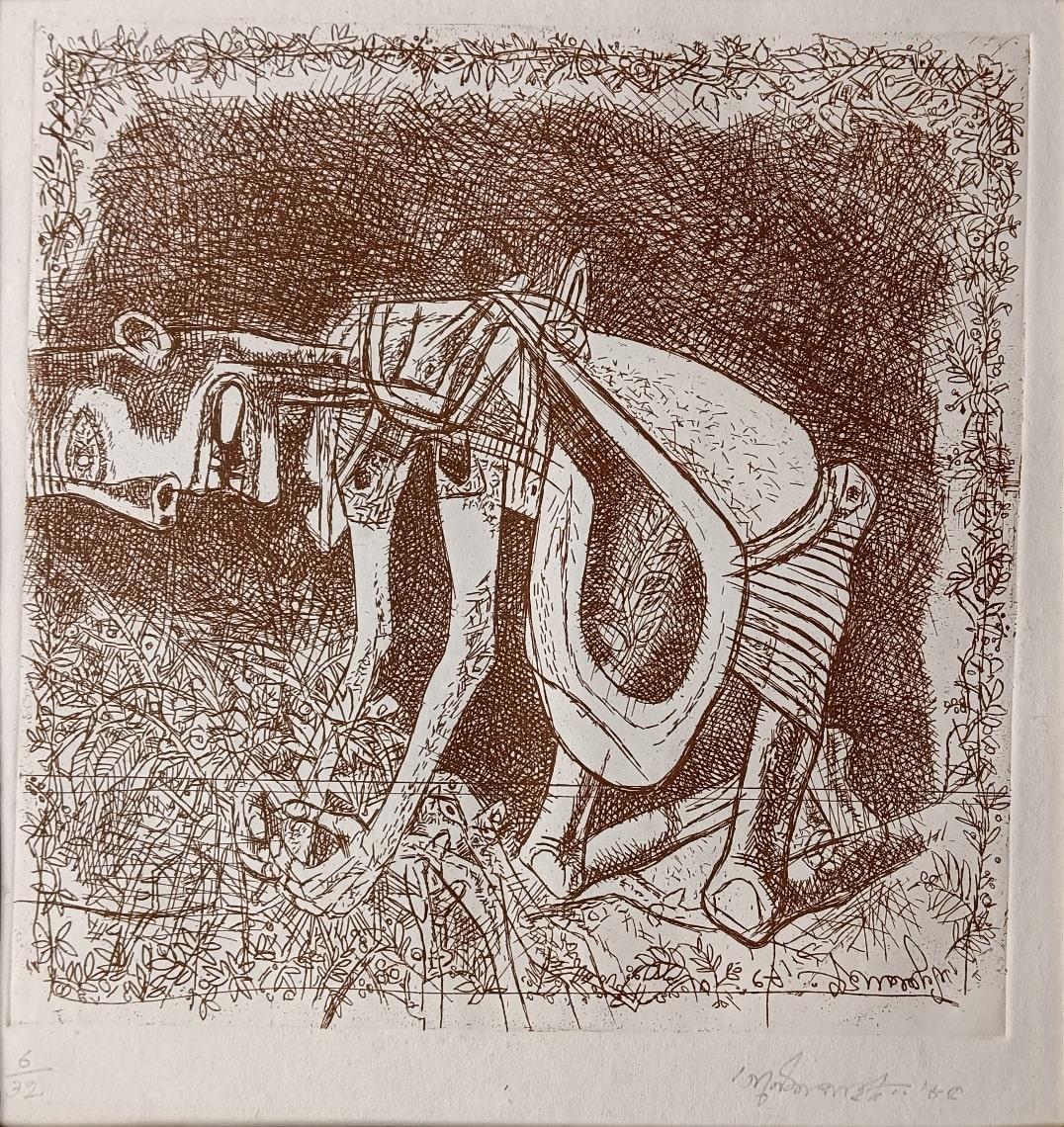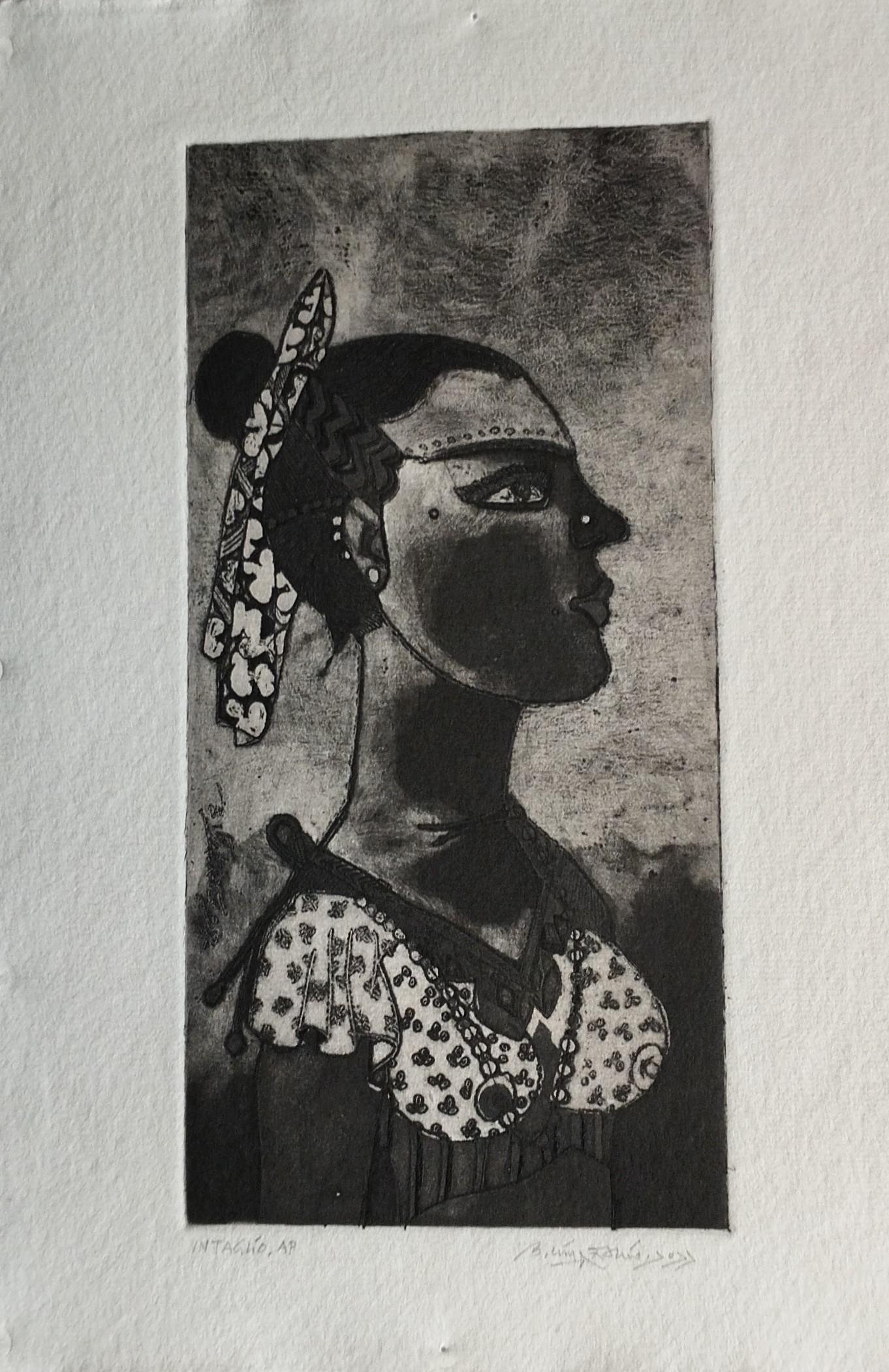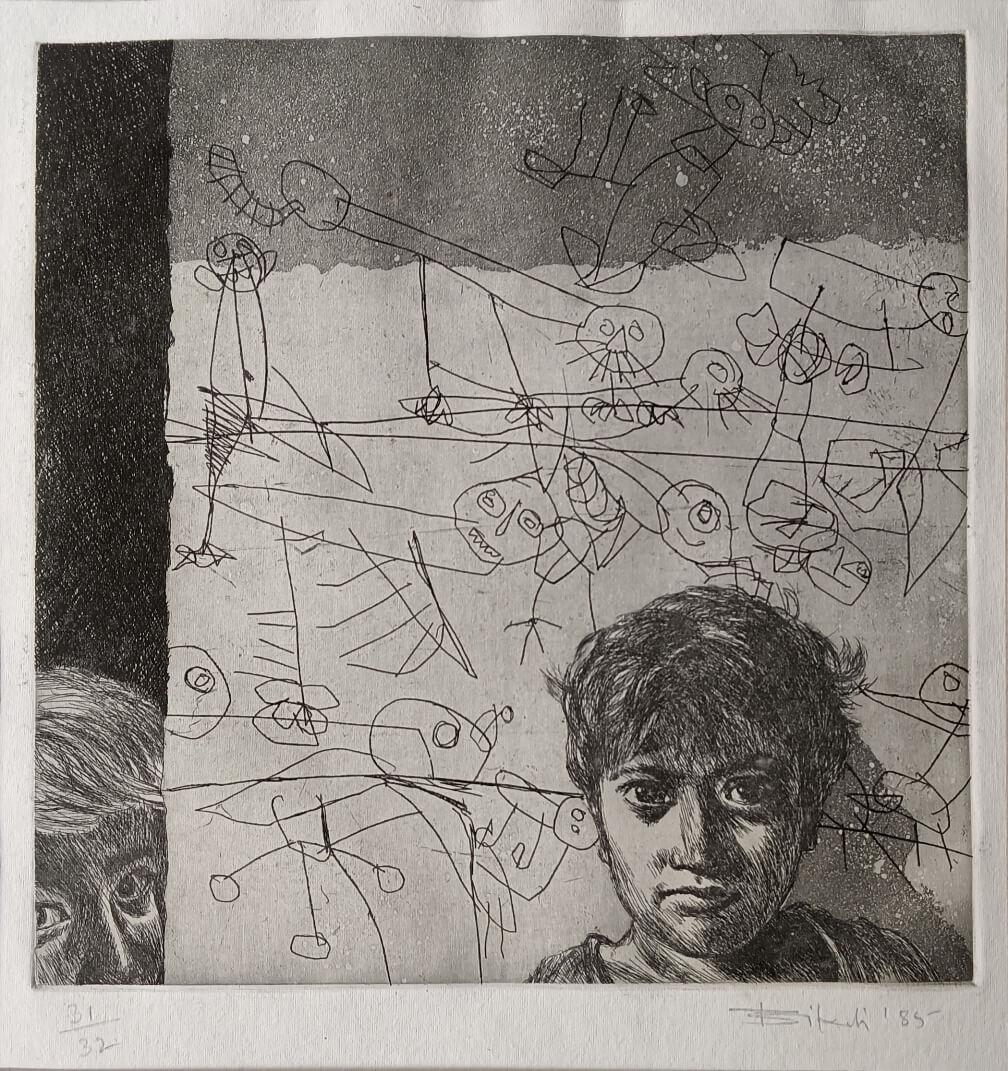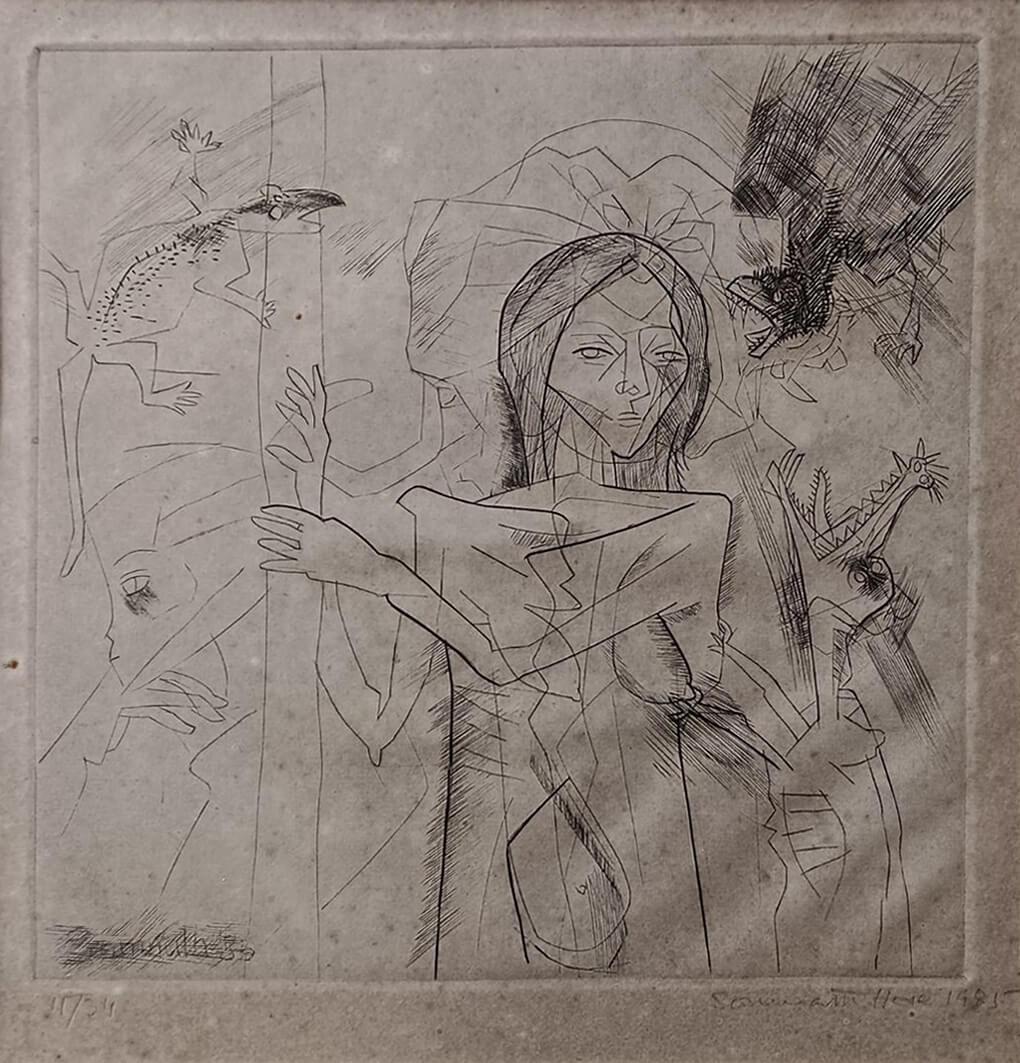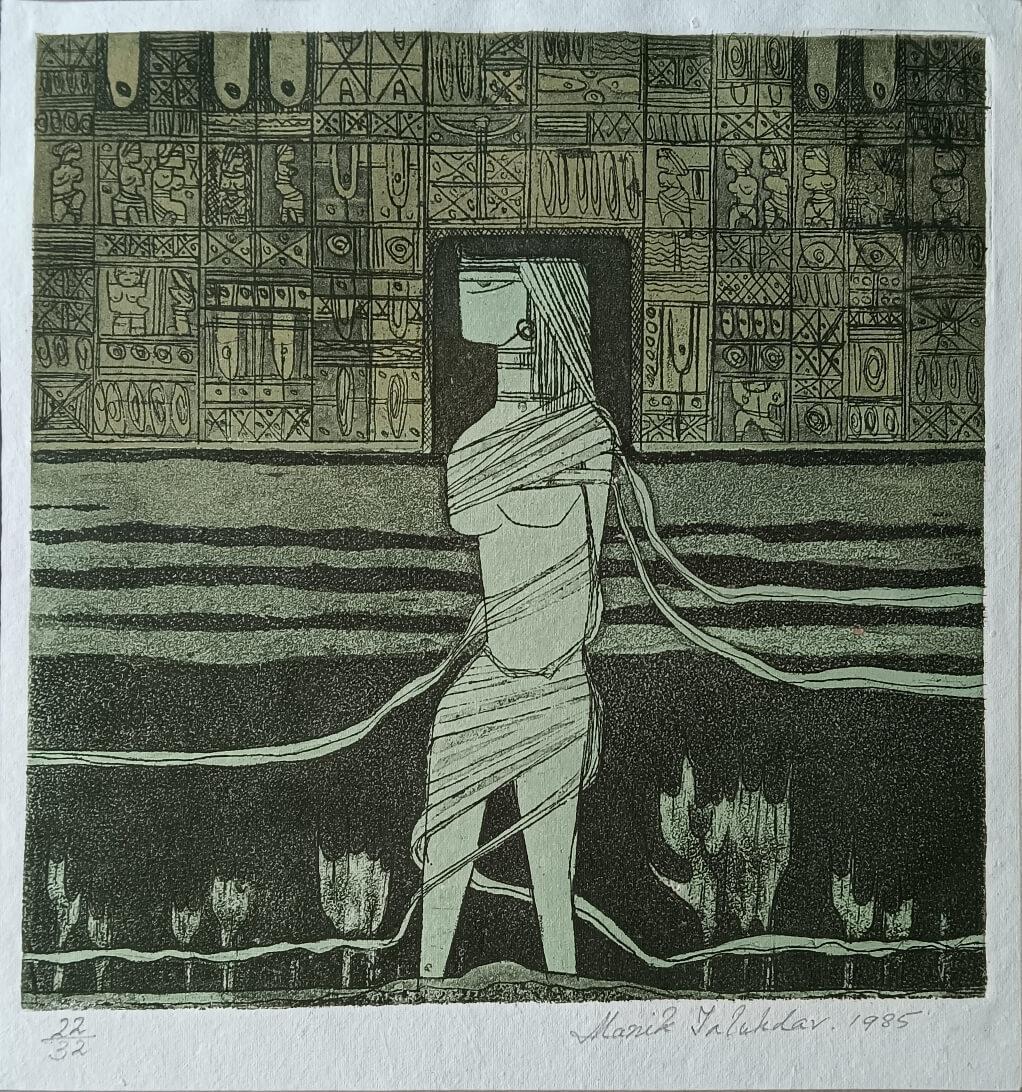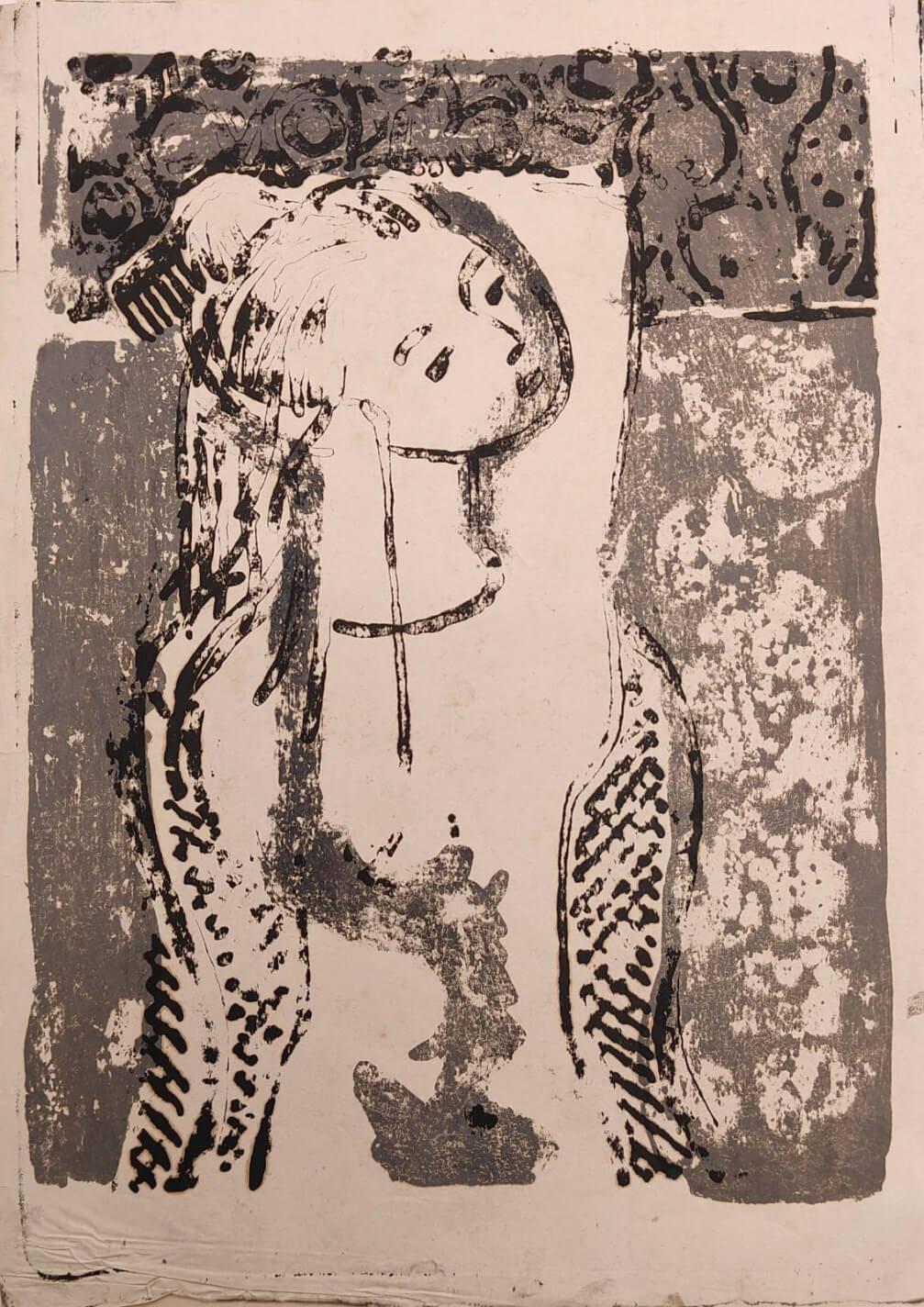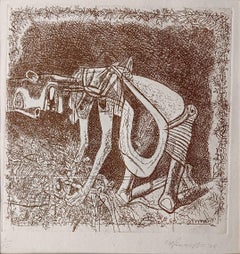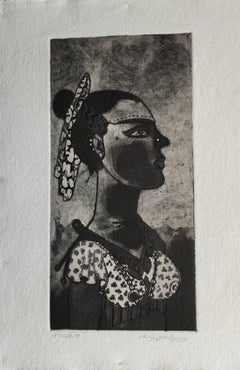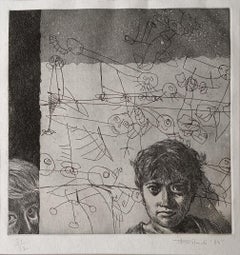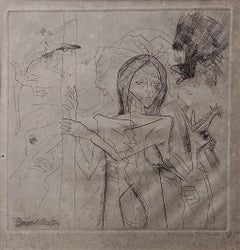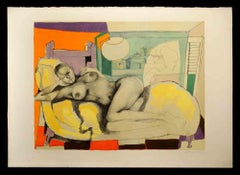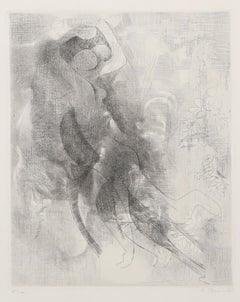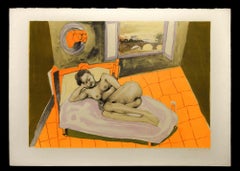Items Similar to Untitled, Etching on Paper by Modern Artist Atul Dodiya "In Stock"
Want more images or videos?
Request additional images or videos from the seller
1 of 5
Atul DodiyaUntitled, Etching on Paper by Modern Artist Atul Dodiya "In Stock"2017
2017
$1,560
£1,215.54
€1,379
CA$2,242.07
A$2,468.74
CHF 1,280.15
MX$29,236.62
NOK 16,250.65
SEK 15,188.08
DKK 10,299.47
About the Item
Atul Dodiya
Untitled
Etching on Paper
21 x 14 inches, 2017
( Unframed & Delivered )
In this etching, Atul merges abstraction and figuration to explore the vulnerability of the human form. The fluid lines and stark contrasts evoke a surreal, dreamlike landscape that blurs the boundary between memory and imagination.
Born in Bombay, India on January 20, 1959, to a family that had migrated to the west-coast metropolis from Kathiawar in Gujarat, Atul Dodiya is one of India’s most acclaimed postcolonial artist who refuses to confine himself to a box neatly labelled with a national identity; his location in India serves him as a base from which to intervene in a variety of cultural and political histories to which the postcolonial self is heir.
Dodiya’s paintings, assemblages and sculpture-installations embody a passionate, sophisticated response to the sense of crisis he feels, as an artist and as a citizen, in a transitional society damaged by the continuing asymmetries of capital yet enthused by the transformative energies of globalization. When Dodiya was ten, he suffered an injury to the eye while playing with friends in a century-old village-like neighborhood of DK Wadi in Bombay. That same year, he felt in his bones the absolute conviction that he wanted to be an artist. For the next twenty-five years, he would be plagued by the artist’s worst nightmare: the fear of impending blindness. Regardless of this, he embraced the life of the studio, committing himself to the edge of severe visual impairment, a condition eventually and permanently remedied by surgery. But by the mid-1990s, Dodiya’s voracious desire to record a diverse range of experiences by painterly means had already made him a front-runner of his generation of post-colonial Indian artists. A number of paintings that date to this early phase of his career attest to this potentially destabilizing yet dynamically productive tension in his consciousness. Like many of his contemporaries, Dodiya enacted a radical departure from the modernist dogmas of stylistic singularity and medium-specificity; he replaced these with a dazzling and extravagant multiplicity of styles and a repertoire of media among which he ranges with the zest and adroitness of an orchestral imagination. In February 2002, a brazenly ascendant Hindu Right wing would orchestrate a genocide against the Muslim minority in the state of Gujarat, plunging Gujaratis of liberal persuasion, such as Dodiya, into profound dejection. As one who had long subscribed to Gandhi’s philosophy of compassion, mutuality and non-violence, Dodiya was especially disturbed by these events that cataclysmically bookend the decade 1992-2002 of his life which came to inform his art strongly.
Dodiya registered another turning point in 1991-1992, the year he and his wife, the artist Anju Dodiya, spent largely in Paris on a French Government scholarship: his understanding of his own location as an artist underwent a radical transformation during this period. At 32 , he was leaving India for the first time; and for the first time, he would see in actuality, many of the canonical works of art and legendary institutions that had inspired him as a student and young artist. Shocked with his first encounter with original works by Picasso, Modigliani and several magisterial figures in the western art scene, he began to reassess the modernist doctrines in which he had been raised in Bombay, in relation to what he saw to be far more mercurial and experimental course of the 20th century art. After his return from Paris in 1992, living there for a year and seeing so much art, Dodiya wanted to change many things in his work. ‘In Paris I overcame my anxieties about what Tyeb would say, what Akbar would say, what my friends would say. Their opinion still mattered to me and I took it very seriously, but I knew that I simply had to do what I felt I had to do. I allowed for the new experiences, expressions. I began to develop a feeling for a different kind of subject matter and came up with a reshuffled realism”, says Dodiya.
Importantly, through the late 1990s, Dodiya revitalized the painted surface by responding to the challenges posed by new mediatic structure such as satellite television and the internet on the one hand, and by new artistic modes such as vide0, assemblage and installation on the other. He began to construct his paintings as argument, allegories, riddles, or aphorisms. In so re-engineering the machinery of the painting, he brought a gamut of unpredictable and mutually unrelated energies to bear on pictorial space: his corpus of references soon grew to include poems, comic strips, traders’ lists of wares, advertising billboards, movie posters, cinema stills, popular religious oleographs, and streetside graffiti, as well as his favorite paintings from the postcolonial Indian, Mughal, European and American traditions By 1999, Dodiya’s transformation was complete. He was far more readily identified with a flamboyantly hybrid idiom in which the distinctions between classical and demotic, regional and international, beaux arts and popular culture, had not simply been blurred but actively broken down in the interests of a fictive, sparking, idiosyncratic collage of impulses.
Awards
Gold Medal Award, Government of Maharashtra, India, 1982
Scholarship Award, French Government, 1990
Sanskriti Award, 1995
Sotheby’s Prize, 1999
Civitella Ranieri Foundation Fellowship, Italy, 1999
Raza Award, Raza Foundation, 2008
About the Seller
4.9
Vetted Professional Seller
Every seller passes strict standards for authenticity and reliability
Established in 2004
1stDibs seller since 2017
131 sales on 1stDibs
Typical response time: 8 hours
- ShippingRetrieving quote...Shipping from: Kolkata, India
- Return Policy
More From This Seller
View AllUntitled, Etching on Paper by Modern Indian Artist Ganesh Pyne "In Stock"
By Ganesh Pyne
Located in Kolkata, West Bengal
Ganesh Pyne - Untitled
AP - 6/32
Etching on Paper
11 x 10.5 inches, 1985
( Unframed & Delivered )
Style : Initially, Pyne painted watercolors and sketches of misty mornings and ways...
Category
1980s Modern Figurative Prints
Materials
Paper, Etching
Untitled, Intaglio on Paper, Modern Indian Artist "In Stock"
By Laxma Goud
Located in Kolkata, West Bengal
K. Laxma Goud - Untitled, Intaglio - 12.5 x 9.5 inches (unframed size)
Etching on Paper, 2022
( Unframed & Delivered )
Style : Goud displays versatility over a range of mediums, fro...
Category
2010s Modern Figurative Paintings
Materials
Paper, Etching
Untitled, Figurative, Lithograph on Paper by Bikash Bhattacharjee "In Stock"
By Bikash Bhattacharjee
Located in Kolkata, West Bengal
Bikash Bhattacharjee - Untitled
AP - 31/32
Lithograph on Paper
11 x 10.5 inches, 1985
( Unframed & Delivered )
Style : Bikash Bhattacharya is credited with bringing realism back to...
Category
1980s Modern Figurative Paintings
Materials
Paper, Etching
Untitled, Etching on Paper, Figurative by Artist Somnath Hore "In Stock"
By Somnath Hore
Located in Kolkata, West Bengal
Somnath Hore - Untitled
AP - 11/34, Etching on Paper
11 x 10.5 inches, 1985
(Unfamed & Delivered)
Figurative work by Master Sculptor and Painter Somenath Hore. A gorgeous subtle ren...
Category
1970s Modern More Art
Materials
Paper, Lithograph, Etching
Untitled, AP-22/32, Etching Paper Indian Modern Artist Manik Talukdar "In Stock"
Located in Kolkata, West Bengal
Manik Talukdar - Landscape
AP - 19/12
Etching on Paper
11 x 10.5 inches, 1985
( Unframed & Delivered )
Talukdar has done diploma in Fine Arts, specializing in sculpture. He has had ...
Category
1980s Modern Figurative Prints
Materials
Paper, Etching
Girl, Figurative, Lithograph on Paper by Artist Somnath Hore "In Stock"
By Somnath Hore
Located in Kolkata, West Bengal
Somnath Hore - Girl
Lithograph on Paper
19.25 x 14.5 inches
( Unframed & Delivered )
Inclusive of shipment mounted not framed, Should you wish to receive the same framed and shipped...
Category
1970s Modern More Art
Materials
Lithograph, Paper
You May Also Like
Untitled - Lithograph by Ugo Attardi - 1985
By Ugo Attardi
Located in Roma, IT
Lithograph realized by Ugo Attardi in 1985.
Very good condition.
Ugo Attardi was born in Sori, near Genoa, in 1923 - 2006
In 1948 in Rome he shared with Carla Accardi, Pietro Consa...
Category
1980s Contemporary Figurative Prints
Materials
Lithograph
Untitled - Lithograph by Ugo Attardi - 1985
By Ugo Attardi
Located in Roma, IT
Lithograph realized by Ugo Attardi in 1985.
Very good condition.
Ugo Attardi was born in Sori, near Genoa, in 1923 - 2006
In 1948 in Rome he shared with Carla Accardi, Pietro Consa...
Category
1980s Contemporary Figurative Prints
Materials
Lithograph
Composition, Signed Surrealist Etching by Andre Beaudin
By Andre Beaudin
Located in Long Island City, NY
Composition
Andre Beaudin, French (1895–1972)
Date: 1934
Etching on Arches, signed and numbered in pencil
Edition of 81/100
Image Size: 11.75 x 9.25 inches
Size: 24.25 x 18.25 in. (6...
Category
1930s Surrealist Nude Prints
Materials
Etching
Untitled - Lithograph by Ugo Attardi - 1985
By Ugo Attardi
Located in Roma, IT
Color lithograph, on Fabriano rosaspina paper. Paper size 70cmx50cm, work size 53cmx40cm. Excellent condition, slight signs of wear, no defects.
Ugo Attardi was born in Sori, near G...
Category
1980s Contemporary Figurative Prints
Materials
Lithograph
Untitled - Lithograph by Ugo Attardi - 1985
By Ugo Attardi
Located in Roma, IT
Color lithograph, on Fabriano rosaspina paper. Paper size 70cmx50cm, work size 53cmx40cm. Excellent condition, slight signs of wear, no defects.
Ugo Attardi was born in Sori, near Ge...
Category
1980s Contemporary Figurative Prints
Materials
Lithograph
Untitled - Lithograph by Tono Zancanaro - 1966
By Tono Zancanaro
Located in Roma, IT
Untitled is a modern artwork realized by Tono Zancanaro in 1966.
Black and white lithograph.
Hand signed and dated on the lower margin.
Artist's proof (as reported on the lower ma...
Category
1960s Contemporary Figurative Prints
Materials
Lithograph
More Ways To Browse
19th Century Painting Lovers
Androgynous Figure
April Street
B Gregory
Bird Cage Painting
Clinton Hill
Cream Of Wheat Paintings
Dandy Painting
Daud Akhriev
Dutch Realism
Eugene Fromentin
Flamenco Dancer Paintings
Francesco Albani
Girl In Pink Dress
Hockey Painting
Indian Dance Painting
Jacques Doucet
London Transport Museum Vintage Posters
